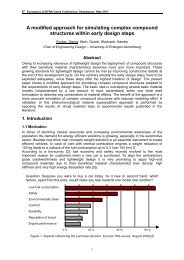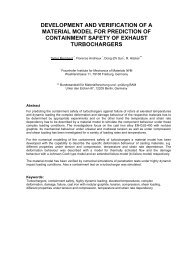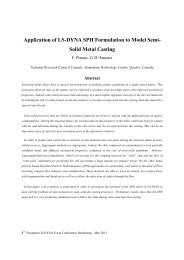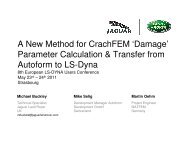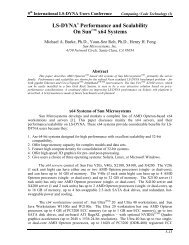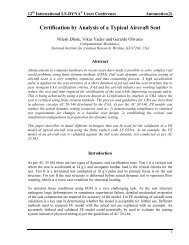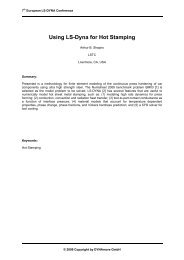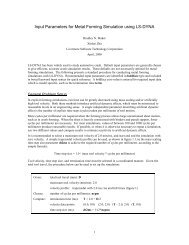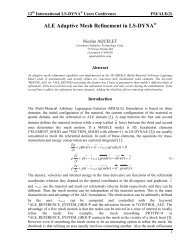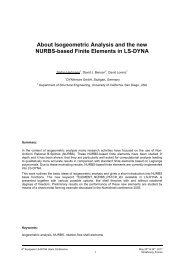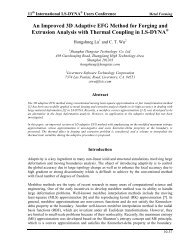Development of a thorax finite element model for ... - DYNAlook
Development of a thorax finite element model for ... - DYNAlook
Development of a thorax finite element model for ... - DYNAlook
You also want an ePaper? Increase the reach of your titles
YUMPU automatically turns print PDFs into web optimized ePapers that Google loves.
Numerical simulations are an important tool in the understanding and the prediction <strong>of</strong> the<br />
biomechanical response <strong>of</strong> the human <strong>thorax</strong> against the impact <strong>of</strong> KENLW. But there are<br />
many challenges as reliable results depend not on accurate material <strong>model</strong>ing, the geometric<br />
<strong>model</strong>ing and the contact between different <strong>thorax</strong> organs. We have shown that through the<br />
problem <strong>of</strong> the lung material the difficulty in the material <strong>model</strong>ing <strong>of</strong> the human body. Each<br />
person is unique, there<strong>for</strong>e there exist a great variability in the properties <strong>of</strong> a human<br />
depending <strong>of</strong> many factors (gender, age,…).<br />
The way all organs interact is important <strong>for</strong> the definition <strong>of</strong> the contact type. We have shown<br />
that depending <strong>of</strong> the type <strong>of</strong> the problem, the choice <strong>of</strong> which parameter or which option to<br />
use is not simple.<br />
References<br />
[1] NATO mission statement, October 13, 1999<br />
[2] B. Koene, F. Id-Boufker, A. Papy, Kinetic Non-Lethal Weapons, Netherlands Annual<br />
Review <strong>of</strong> Military Studies, 2008<br />
[3] C. Mesloh, M. Henych, R. Wolf, Less Lethal Weapon Effectiveness, Use <strong>of</strong> Force, and<br />
Suspect & Office Injuries: A Five-Year Analysis, 2005-IJ-CX-K050, September 2008<br />
[4] N. Lewer, N. Davison, Non-lethal technologies—an overview, Science, Technology and<br />
the CBW Regimes, 2005<br />
[5] C.A. Bir, The evaluation <strong>of</strong> blunt ballistic impacts <strong>of</strong> <strong>thorax</strong>, Ph. D. Thesis, Wayne State<br />
University, Detroit,2000.<br />
[6] http://www.etcvsg.com/surgicalprocedures.html/<br />
[7] http://www.valeedge.com/edgicine/cutting_edge_apr04.html<br />
[8] A.Bouamal, H.Lévesque, <strong>Development</strong> and validation <strong>of</strong> a <strong>finite</strong> <strong>element</strong> human <strong>thorax</strong><br />
<strong>model</strong> under blunt ballistic trauma –Valcartier, Canada, 2007.<br />
[9] N. N. Nsiampa, C. Robbe, A. Papy, Numerical simulation <strong>of</strong> non-lethal projectiles on<br />
human <strong>thorax</strong>, ISB 2011 (to be published)<br />
[10] Stitzel J. D., Gayzik F.S., Hoth J.J., Mercier J., Gage D.H., Morton K.A, Duma S.M,<br />
Payne R.M.,2005, <strong>Development</strong> <strong>of</strong> a Finite Element-Based Injury Metric <strong>for</strong> Pulmonary<br />
Contusion Part I: Model <strong>Development</strong> and Validation, Stapp Car Crash Journal, Vol. 49, The<br />
Stapp Association, pp.271-289.<br />
[11] [5] D.L. Vawter, A <strong>finite</strong> <strong>element</strong> <strong>model</strong> <strong>for</strong> macroscopic de<strong>for</strong>mation <strong>of</strong> the lung, Journal<br />
<strong>of</strong> Biomedical Engineering, February 1980, Vol. 102/1.<br />
[12] K.U. Schmitt, P. Niederer, M. Muser, F. Walz, Trauma Biomechanics – Accidental<br />
injury in traffic and sports, 3rd Ed. – Springer – p. 161.<br />
8th European LS-DYNA Users Conference, Strasbourg - May 2011



